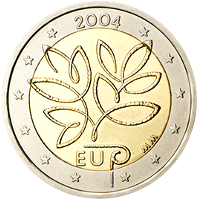 |
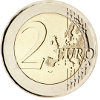 |
C o m m e m o r a t i v e
C o i n s |
||
| Finland | |||||||
The edge lettering on the Finnish 2‐Euro‐commemorative coins is : (Finland in Finnish and Swedish; depicted are three lions) Different embossings are noted in the individual description. |
2007‐2009 / from 2010   |
||||||
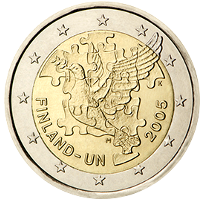 🔎
🔎 |
 |
Finland | 25 Oct. 2005 | 60th anniversary of the establishment of the United Nations and 50th anniversary of Finland's UN membership |
20001 20002 20005 |
2,000,000 |  |
Instead of the standard Finnish edge lettering, this commemorative coin uses "YK 1945‐2005 FN" followed by three lion heads (the lion is the heraldic animal of Finland) as the edge lettering. "YK" and "FN" are the acronyms for "United Nations" in Finnish and Swedish. |
|||||||
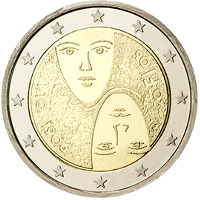 🔎
🔎 |
 |
Finland | 04 Oct. 2006 | 1st Centenary of the Introduction of Universal and Equal Suffrage |
20001 20002 20005 |
2,500,000 |  |
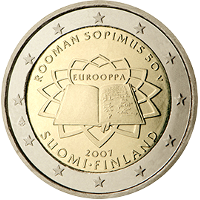 🔎
🔎 |
 |
Finland | 25 Mar. 2007 | 50th anniversary of the Signature of the Treaty of Rome |
20001 20002 20005 |
1,400,000 |  |
National characteristics : At the top are the words "ROOMAN SOPIMUS 50 V" (50th anniversary of the Treaty of Rome), below it is an illustration of the treaty with the words "EUROOPPA" |
|||||||
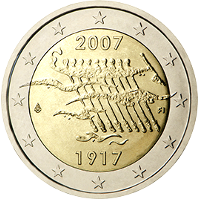 🔎
🔎 |
 |
Finland | 03 Dec. 2007 | 90th anniversary of Finland's independence |
20001 20002 20005 |
2,000,000 |  |
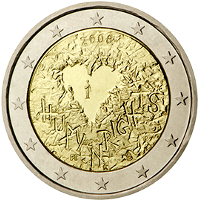 🔎
🔎 |
 |
Finland | 24 Oct. 2008 | 60th anniversary of the Universal Declaration of Human Rights |
20001 20002 20005 |
1,500,000 |  |
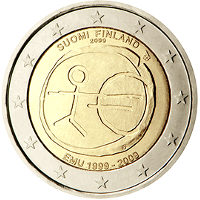 🔎
🔎 |
 |
Finland | 15 Jan. 2009 | 10 years of Economic and Monetary Union (EMU) |
20001 20002 20005 |
1,400,000 |  |
National characteristics : Above is the name of the issuing country "SUOMI FINLAND" (Finland, in Finnish and Swedish), the acronym of the occasion of issue below is "EMU". A horn of plenty with rounds the mint mark of the Finnish mint Suomen Rahapaja OY in Vantaa is to the right of the country name, the year of issue "2009" is shown below the name. Coins produced in the proof production process bear the normal Finnish edge marking, but the normal mittings bear the marking "TALOUS ‐ RAHALIITTO EMU •" (Economic and Monetary Union, in Finnish). |
|||||||
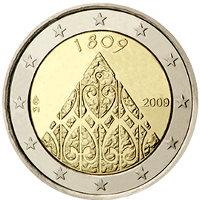 🔎
🔎 |
 |
Finland | 23 Oct. 2009 | 200th anniversary of Finnish Autonomy |
20001 20002 20005 |
1,600,000 |  |
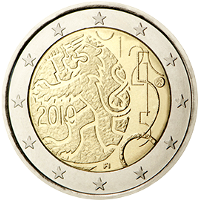 🔎
🔎 |
 |
Finland | 11 Nov. 2010 | 150th anniversary of Finnish Currency |
20001 20002 20005 |
1,600,000 |  |
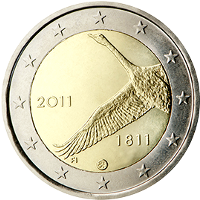 🔎
🔎 |
 |
Finland | 17 Oct. 2011 | 200th anniversary of the Finnish Central Bank Suomen Pankki |
20001 20002 20005 |
1.600,000 |  |
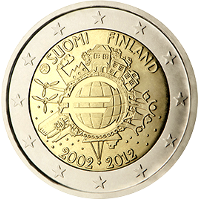 🔎
🔎 |
 |
Finland | 12 Jan. 2012 | 10 years Euro‐Currency |
20001 20002 20005 |
1,500,000 |  |
National characteristics : At the top of the coin is the name of the issuing country "SUOMI FINLAND" (Finland, in Finnish and Swedish). The mint mark of the Finnish mint Suomen Rahapaja OY in Vantaa a lion (the heraldic animal of Finland) can be seen on the left. |
|||||||
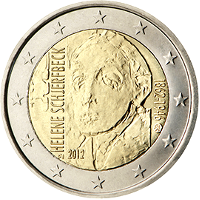 🔎
🔎 |
 |
Finland | 05 Oct. 2012 | 150th birthday of Helene Schjerfbeck |
20001 20002 20005 |
2,000,000 |  |
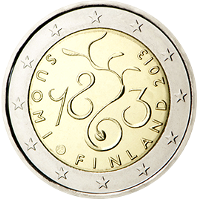 🔎
🔎 |
 |
Finland | 04 Sep. 2013 | 150th anniversary of the Parliament of 1863 when regular Parliament sessions started in Finland |
20001 20002 20005 |
1,000,000 |  |
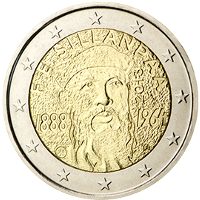 🔎
🔎 |
 |
Finland | 04 Nov. 2013 | 125th anniversary of the birth of Nobel Prize‐winning author Frans Eemil Sillanpää |
20001 20002 20005 |
1,500,000 |  |
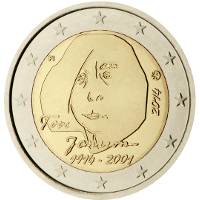 🔎
🔎 |
 |
Finland | 16 Jun. 2014 | 100th birthday of Tove Jansson |
20001 20002 20005 |
1,500,000 |  |
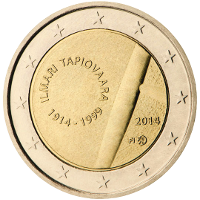 🔎
🔎 |
 |
Finland | 10 Nov. 2014 | 100th birthday of Ilmari Tapiovaara |
20001 20002 20005 |
1,000,000 |  |
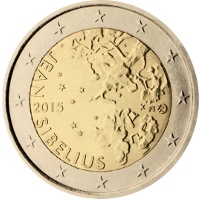 🔎
🔎 |
 |
Finland | 18 Feb. 2015 | 150th birthday of the composer Jean Sibelius |
20001 20002 20005 |
1,000,000 |  |
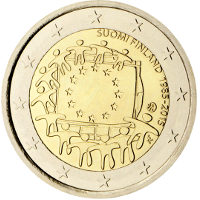 🔎
🔎 |
 |
Finland | 06 Aug. 2015 | 30 years EU‐Flag |
20001 20002 20005 |
500,000 |  |
National characteristics : Above is the name of the issuing country "SUOMI FINLAND" (Finland, in Finnish and Swedish), followed by the dates "1985‐2015". A lion (the heraldic animal of Finland) the mint mark of the Finnish mint Suomen Rahapaja OY in Vantaa is shown on the right. |
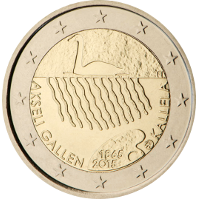 🔎
🔎 |
 |
Finland | 22 Oct. 2015 | 150th birthday of Akseli Gallen-Kallela |
20001 20002 20005 |
500,000 |  |
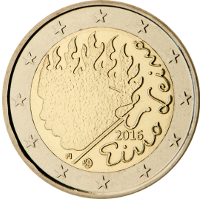 🔎
🔎 |
 |
Finland | 25 Apl. 2016 | 90th anniversary of the death of Eino Leino |
20001 20002 20005 |
1,000,000 |  |
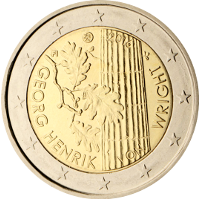 🔎
🔎 |
 |
Finland | 17 Oct. 2016 | 100th birthday of philosopher Georg Henrik von Wright |
20001 20002 20005 |
1,000,000 |  |
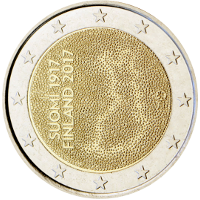 🔎
🔎 |
 |
Finland | 01 Jun. 2017 | 100 years of independence |
20001 20002 20005 |
2,500,000 |  |
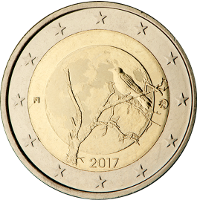 🔎
🔎 |
 |
Finland | 23 Oct. 2017 | Finnish Nature |
20001 20002 20005 |
500,000 |  |
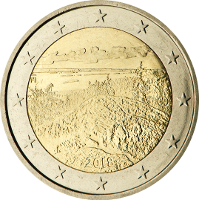 🔎
🔎 |
 |
Finland | 28 May 2018 | Koli National Park |
20001 20002 20005 |
1,000,000 |  |
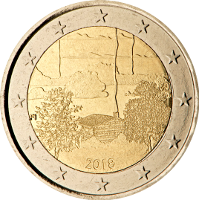 🔎
🔎 |
 |
Finland | 22 Oct. 2018 | Finnish Sauna culture |
20001 20002 20005 |
1,000,000 |  |
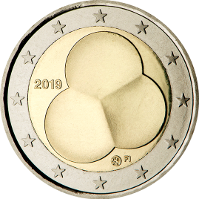 🔎
🔎 |
 |
Finland | 31 Oct. 2019 | Constitution Act of 1919 |
20001 20002 20005 |
500,000 |  |
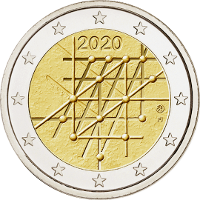 🔎
🔎 |
 |
Finland | 18 Aug. 2020 | 100 years since the foundation of the University of Turku |
20002 20007 20008 |
720,000 |  |
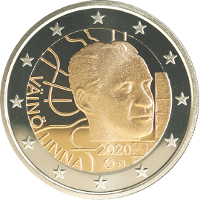 🔎
🔎 |
 |
Finland | 11 Nov. 2020 | 100th anniversary of Väinö Linna |
20002 20007 20008 |
700,000 |  |
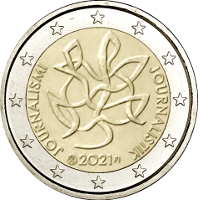 🔎
🔎 |
 |
Finland | 14 Apr. 2021 | Journalism and Open Communication in Support of Finnish Democracy |
20002 20007 20008 |
530,000 |  |
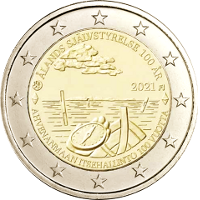 🔎
🔎 |
 |
Finland | 13 Aug. 2021 | 100th anniversary of self‐government in the Åland region |
20002 20007 20008 |
800,000 |  |
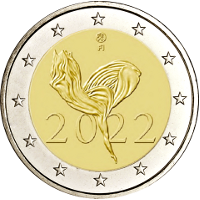 🔎
🔎 |
 |
Finland | 11 Feb. 2022 | 100th anniversary of the Finnish National Ballet |
20002 20003 20005 |
400,000 |  |
 Work in progress |
|||||||
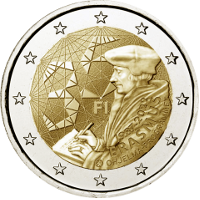 🔎
🔎 |
 |
Finland | 01 Jul. 2022 | 35th anniversary of the Erasmus Program |
20003 20005 20009 |
400,000 |  |
National characteristics : The country abbreviation "FI" (Finland) is placed centrally below the centre line. The quarter circle at the bottom right has three lines; below the commemorative period is the issue occasion "ERASMUS" and below that "OHJELVA • PROGRAMMET" (Programme, in Finnish and Swedish). A lion (the heraldic animal of Finland) is depicted at the bottom on the left sleeve as the mint mark of the Finnish mint Suomen Rahapaja OY in Vantaa. |
|||||||
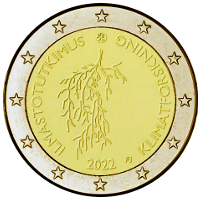 🔎
🔎 |
 |
Finland | 30 Seb. 2022 | Climate research in Finland |
20003 20005 20009 |
400,000 |  |
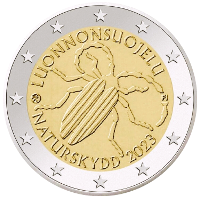 🔎
🔎 |
 |
Finland | 21 Mar. 2023 | First Finnish Nature Conservation Act (1932) |
20003 20005 20009 |
405,000 |  |
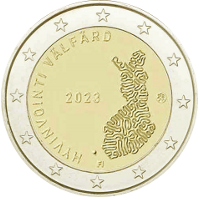 🔎
🔎 |
 |
Finland | 07 Aug. 2023 | Social and health services as safeguards for citizens' well‐being |
20003 20005 20009 |
400,000 |  |
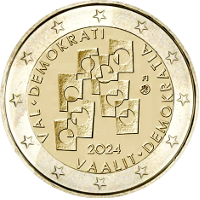
|
 |
Finland | 14 Mar. 2024 | Elections as the basis of democracy | 20003 | 407,800 |  |
 Work in progress |
|||||||
| References : | |||
| 20001 | Images taken with authorisation by the ECB ‐ Mail dated 20.Feb.2020 © "European Central Bank" |
20002 | Data mirrored from Wikipedia Page "2_euro_commemorative_coins" with friendly support of the guardians of that page. |
| 20003 | Images taken with authorisation by H....... Hamburg | 20004 | Coloured version of this Commemorative Coin in circulation EU‐legal‐technical specifications do not recongnise colour prints, but the EU is tolerate them, due to the facts that their numbers are very small and that they are sold in special packs and therefor are very unlikely to be used as currency. |
| 20005 |
enlarged Images taken with authorisation by Gerd Seyffert © "Gerd Seyffert 2021" |
20006 | Not Applicable |
| 20007 | Images taken by Münzen Kreuzberg © "Münzen Kreuzberg 2021" |
20008 | enlarged Images taken by Münzen Kreuzberg © "Münzen Kreuzberg 2021" |
| 20009 | Text with kind permission by Gerd Seyffert © "Gerd Seyffert 2023" |
20010 | Not Applicable |
 |
